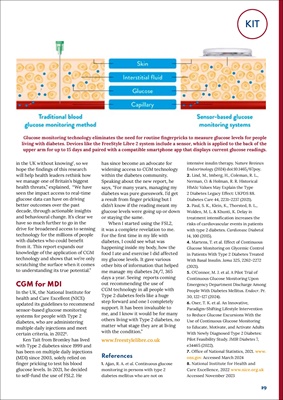
19
KIT
in the UK without knowing7, so we
hope the findings of this research
will help health leaders rethink how
we manage one of Britain's biggest
health threats," explained, "We have
seen the impact access to real-time
glucose data can have on driving
better outcomes over the past
decade, through actionable insights
and behavioural change. It's clear we
have so much further to go in the
drive for broadened access to sensing
technology for the millions of people
with diabetes who could benefit
from it. This report expands our
knowledge of the application of CGM
technology and shows that we're only
scratching the surface when it comes
to understanding its true potential."
CGM for MDI
In the UK, the National Institute for
health and Care Excellent (NICE)
updated its guidelines to recommend
sensor-based glucose monitoring
systems for people with Type 2
diabetes, who are administering
multiple daily injections and meet
certain criteria, in 20228.
Ken Tait from Bromley has lived
with Type 2 diabetes since 1999 and
has been on multiple daily injections
(MDI) since 2003, solely relied on
finger pricking to test his blood
glucose levels. In 2021, he decided
to self-fund the use of FSL2. He
has since become an advocate for
widening access to CGM technology
within the diabetes community.
Speaking about the new report, he
says, "For many years, managing my
diabetes was pure guesswork. I'd get
a result from finger pricking but I
didn't know if the reading meant my
glucose levels were going up or down
or staying the same.
When I started using the FSL2,
it was a complete revelation to me.
For the first time in my life with
diabetes, I could see what was
happening inside my body, how the
food I ate and exercise I did affected
my glucose levels. It gave various
other bits of information that helped
me manage my diabetes 24/7, 365
days a year. Seeing reports coming
out recommending the use of
CGM technology in all people with
Type 2 diabetes feels like a huge
step forward and one I completely
support. It has been invaluable to
me, and I know it would be for many
others living with Type 2 diabetes, no
matter what stage they are at living
with the condition."
www.freestylelibre.co.uk
References
1. Ajjan, R. A. et al. Continuous glucose
monitoring in persons with type 2
diabetes mellitus who are not on
intensive insulin therapy. Nature Reviews
Endocrinology (2024) doi:10.1465/67poy.
2. Lind, M., Imberg, H., Coleman, R. L.,
Nerman, O. & Holman, R. R. Historical
HbA1c Values May Explain the Type
2 Diabetes Legacy Effect: UKPDS 88.
Diabetes Care 44, 2231-2237 (2021).
3. Paul, S. K., Klein, K., Thorsted, B. L.,
Wolden, M. L. & Khunti, K. Delay in
treatment intensification increases the
risks of cardiovascular events in patients
with type 2 diabetes. Cardiovasc Diabetol
14, 100 (2015).
4. Martens, T. et al. Effect of Continuous
Glucose Monitoring on Glycemic Control
in Patients With Type 2 Diabetes Treated
With Basal Insulin. Jama 325, 2262-2272
(2021).
5. O'Connor, M. J. et al. A Pilot Trial of
Continuous Glucose Monitoring Upon
Emergency Department Discharge Among
People With Diabetes Mellitus. Endocr. Pr.
30, 122-127 (2024).
6. Oser, T. K. et al. An Innovative,
Paradigm-Shifting Lifestyle Intervention
to Reduce Glucose Excursions With the
Use of Continuous Glucose Monitoring
to Educate, Motivate, and Activate Adults
With Newly Diagnosed Type 2 Diabetes:
Pilot Feasibility Study. JMIR Diabetes 7,
e34465 (2022).
7. Office of National Statistics, 2021. www.
ons.gov. Accessed March 2024
8. National Institute for Health and
Care Excellence, 2022 www.nice.org.uk
Accessed November 2023
Glucose monitoring technology eliminates the need for routine fingerpricks to measure glucose levels for people
living with diabetes. Devices like the FreeStyle Libre 2 system include a sensor, which is applied to the back of the
upper arm for up to 15 days and paired with a compatible smartphone app that displays current glucose readings.